Back pain is one of the most common physical complaints people have. 80% of Americans complain of back pain at some point in their lives. Learning to stop overusing your spine (which we do to avoid having to stretch big hip and shoulder muscles) can help keep your spine safer. In addition, learning to lengthen and compress your spine intentionally and safely can improve the health of your spinal discs, further reducing the occurrence of back pain.
Herniated discs are a major spinal health concern
One of the most common causes of acute spinal trouble is asymmetrical over-compression of one of the intervertebral discs. This is especially common in the lumbar spine. It can lead to tears in the tough outer layer of the disc (the annulus fibrosus), or even to a rupture of the annulus. Minor ruptures or bulges can heal within weeks, but major ruptures (known as hernias or prolapses) can take months. If you keep re-injuring a herniated disc by perpetuating poor movement patterns, it can even become a chronic problem. One of the main ways in which a herniated disc causes problems is that it can press on the adjacent nerve root exiting the spinal cord, causing nerve pain. (A herniated disc is also sometimes called a “slipped disc.” This is a misnomer as the disc cannot slip. It is fused to the vertebrae above and below.)
So how can we reduce the chance of disc herniations and other spinal problems? We will focus on spinal alignment this week to train ourselves to be mindful of keeping our spines neutral and long in neutral spine poses. In addition, during bending postures, we will focus on distributing the bending forces more evenly along the entire spine and to other joints to avoid over-compressing any single intervertebral disc to the point of injury.
Spinal health includes learning to lengthen and compress the spine
There is another emphasis we can add to spinal movement that can help keep your discs healthy. It involves learning to lengthen and compress your spine. Over a lifetime, an even more common cause of spinal problems than disc rupture is degeneration of the intervertebral discs. This degeneration is easily measurable. As we grow older, we grow shorter as a result of the flattening of the discs and their loss of elasticity. (The other cause of growing shorter is excessive curves in the spine, primarily hyperkyphosis/head forward position.)
Disc health is aided by careful but deliberate compression and expansion of the discs
So how do we keep our discs healthy long term? Intervertebral discs contain living cells which maintain and repair the intricate extra-cellular connective-tissue matrix that makes up the discs. However, these living cells require an ongoing supply of nutrients and oxygen to do their work. They also require the removal of metabolic waste products. The discs lose their blood supply around the age of 25, meaning that past that age the discs have to rely on diffusion for their nutrient supply and waste disposal. Unfortunately, simple diffusion of materials in and out of the discs via the adjacent vertebrae is barely adequate. However, alternately compressing and extending the spine creates a pumping action that increases movement of nutrients into, and waste products out of, the discs.
While lengthening the spine is relatively simple and safe, how do you safely compress your intervertebral discs? After all, I just warned you about the dangers of spinal compression in the second paragraph. Nothing beats spinal twists for relatively safe compression of the discs. This is the case because in a twist the discs are evenly compressed front, back, left, and right. This even compression avoids the potential for disc ruptures caused when only one side of a disc is compressed, as in forward bends. One additional word of caution. Combining twists with forward bends is potentially more dangerous than simple forward bends, even extreme ones. Thus we will emphasize keeping our spines from forward bending when twisting.
Why lengthening the spine aids spinal twists
I never say “straighten your spine” when I want to encourage a neutral spine. A straight or flattened spine is NOT the same thing as the natural double S-curve of the spine. In general, straightening your spine simply compromises your breath, and that is never helpful. However, the one time that we do actually want to straighten the spine is in spinal twists. When we lengthen the spine we end up straightening it by necessity, and thus create two effects that aid safe twisting movements:
1. The lengthening of the spine through the pressurization of the abdominal cavity reduces the internal pressure of the discs. This pressure reduction, in conjunction with the pressure increase during twisting, creates the pumping action that increases the nutrient exchange in the discs.
2. The straightening of the spinal curves that accompanies the lengthening of the torso realigns all the intervertebral joints more closely to the plane in which the twist is happening. The more you align your discs in the plane of twisting, the more evenly the pressure created by the twist will be distributed throughout each disc, keeping them safe.
Try it now: Lengthen and compress your spine
Come to a comfortable cross-legged seat on a cushion, block or chair. Lengthen your spine by allowing the crown of your head to float up. Inhale and allow your left arm to float up. Meanwhile engage your deep core muscles (transversus abdominis and pelvic floor) to pressurize your abdominal cavity. This lengthens the spine and flattens its natural S-curves. If you find this lengthening action difficult, you can aid it by pressing your right hand down into the floor or a block. The feeling of your spine lengthening is that of the crown of your head floating up.
As you exhale, lower your left hand to the opposite knee. Do this by spiraling from the left hip up towards the right shoulder blade. With each subsequent inhale, re-lengthen the spine, making sure to reduce the forward bending that tends to happen when we sit. This is important to evenly distribute the compression to all parts of each disc.
With each subsequent exhale, deepen the twist, gently and evenly increasing compression. As you alternately compress and decompress the spine, visualize waste products escaping from the discs during exhalation, and nutrients dispersing into the discs during inhalation. After 5-10 breaths, return to center on an inhale, and repeat on the other side.
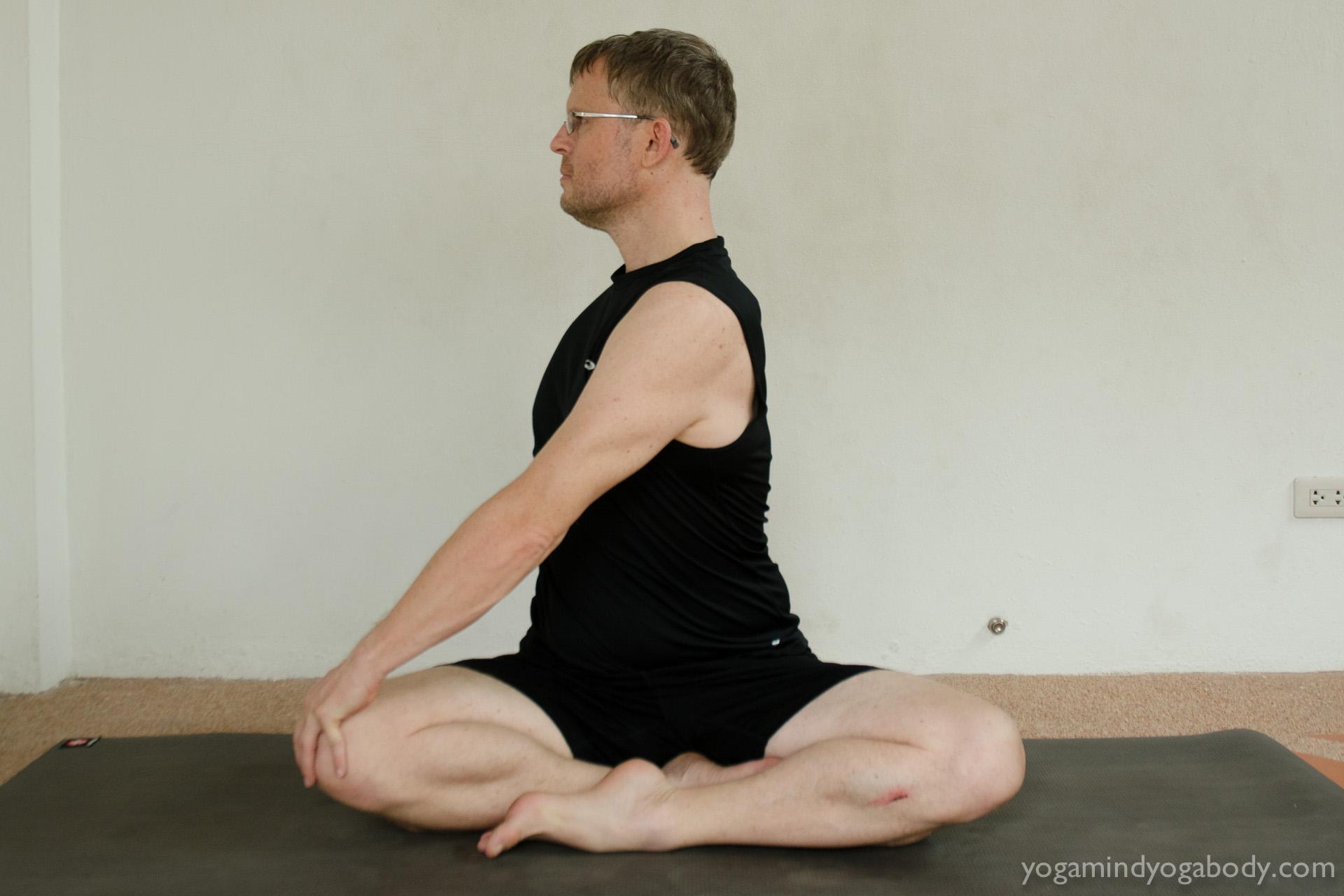
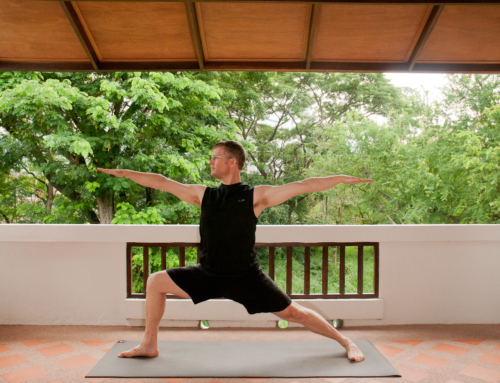
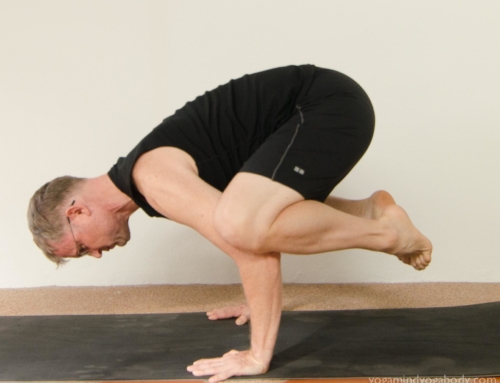
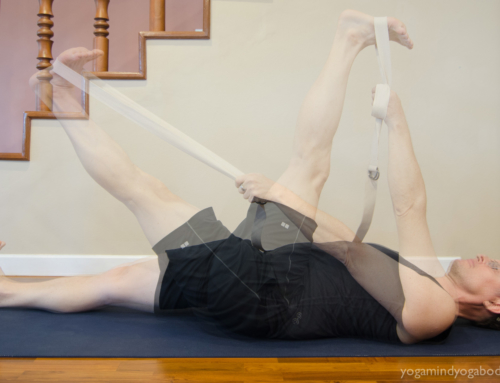
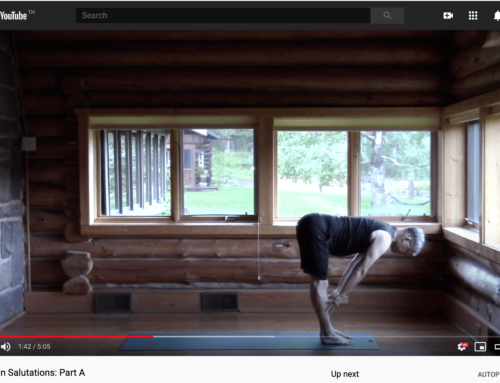

Leave A Comment